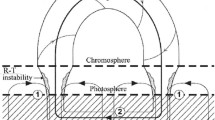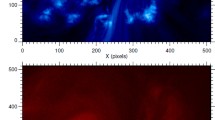Abstract
SOHO and TRACE data have shown that the coronal plasma is heated most actively near sunspots, in magnetic loops that issue from the penumbral region. The source of heating is nonuniform in height, and its power is maximum near the footpoints of the magnetic loops. The heating process is typically accompanied by the injection of dense chromospheric plasma into the coronal parts of the magnetic loops. It is important that the radiative losses cannot be compensated for via electron thermal conduction in the loops, which have temperatures of 1.0–1.5 MK; therefore, some heating source must operate throughout the entire length of the loop, balancing radiative losses and maintaining a quasi-steady state of the loop over at least several hours. As observations show, the plasma density inside the loops exceeds the density of the ambient plasma by more than an order of magnitude. It is supposed that the enhanced plasma density inside the loops results from the development of the ballooning mode of a flute-type instability in the sunspot penumbra, where the plasma of the inner sunspot region, with β i ≪ 1, comes into contact with the dense chromospheric plasma, which has β e ≫ β i (β is the gas-to-magnetic pressure ratio). As the chromospheric plasma penetrates into the potential field of the sunspot, the generated diamagnetic currents balance the excess gas pressure. These currents efficiently decay due to the Cowling conductivity. Even if neutrals are few in number in the plasma (accounting for less than 10−5 of the total mass density), this conductivity ensures a heating rate that exceeds the rate of the normal Joule dissipation of diamagnetic currents by 7–8 orders of magnitude. Helium is an important factor in the context of plasma heating in magnetic loops. Its relatively high ionization potential, while not forbidding dielectronic recombination, ensures a sufficiently high number of neutrals in the coronal plasma and maintains a high heating rate due to the Cowling conductivity, even at coronal temperatures. The heating results from the “burning-out” of the nonpotential component of the magnetic field of the coronal magnetic loops. This mechanism provides the necessary heating rate for the plasma inside the loops if the loops are thin enough (with thickness of the order of 105–106 cm). This may imply that the observed (1–5) × 108-cm-thick loops consist of numerous hot, thin threads. For magnetic loops in hydrostatic equilibrium, the calculated heating function exponentially decreases with height on characteristic scales a factor of 1.8 smaller than the total-pressure scale height, since the scale heights for the total pressure and for the 4He partial pressure are different. The heating rate is proportional to the square of the plasma pressure in the loop, in agreement with observational data.
Similar content being viewed by others
References
D. C. Spicer, in Mechanisms of Chromospheric and Coronal Heating, Ed. by P. Ulmschneider, E. R. Prist, and R. Rosner (Springer-Verlag, Berlin, 1991), p. 547.
A. A. Galeev, R. Rosner, S. Serio, and G. S. Vaiana, Astrophys. J. 243, 131 (1981).
E. N. Parker, Astrophys. J. 330, 447 (1988).
E. N. Parker, in Mechanisms of Chromospheric and Coronal Heating, Ed. by P. Ulmaschneider, E. R. Prist, and R. Rosner (Springer, Berlin, 1991), p. 615.
E. Antonucci, D. Alexander, J. L. Culhane, et al., in The Many Faces of the Sun: A Summary of the Results from NASA’s Solar Maximum Mission, Ed. by K. T. Strong, J. L. R. Saba, B. M. Haisch, and J. T. Schmelz (Springer, Berlin, 1998), p. 331.
P. L. Bornmann, in The Many Faces of the Sun: A Summary of the Results from NASA’s Solar Maximum Mission, Ed. by K. T. Strong, J. L. Saba, B. M. Haisch, and J. T. Schmelz (Springer, Berlin, 1998), p. 301.
J. V. Hollweg, Astrophys. J. 277, 392 (1984).
J. V. Hollweg, in Mechanisms of Chromospheric and Coronal Heating, Ed. by P. Ulmschneider, E. R. Prist, and R. Rosner (Springer, Berlin, 1991), p. 423.
J. Ionson, Astrophys. J. 276, 357 (1984).
J. M. Davila, Astrophys. J. 317, 514 (1987).
L. Ofman, J. M. Davila, and R. S. Steinolfson, Astrophys. J. 421, 360 (1994).
D. B. Melrose and G. A. Dulk, Astrophys. J. 282, 308 (1984).
M. J. Aschwanden, J. S. Newmark, J.-P. Delabourdiniére, et al., Astrophys. J. 515, 842 (1999).
M. J. Aschwanden, D. Alexander, N. Hurlburt, et al., Astrophys. J. 531, 1129 (2000).
F. Reale and G. Pares, Astrophys. J. 528, L45 (2000).
A. Schlüter and L. Biermann, Z. Natürforsch. 5A, 237 (1950).
T. G. Cowling, Magnetohydrodynamics (Adam Hilger, London, 1976), p. 117.
K. Shibasaki, Astrophys. J. 557, 326 (2001).
N. M. Bakhareva, V. V. Zaitsev, and M. L. Khodachenko, Sol. Phys. 139, 299 (1992).
M. Suzuki and J. I. Sakai, Astrophys. J. 465, 393 (1996).
M. Suzuki and J. I. Sakai, Astrophys. J. 487, 921 (1997).
M. Ryutova, R. Shine, A. Title, and J. I. Sakai, Astrophys. J. 492, 402 (1997).
K. Furusawa and J. I. Sakai, Astrophys. J. 540, 1156 (2000).
E. R. Priest, Solar Magnetohydrodynamics (Reidel, Dordrecht, 1982; Mir, Moscow, 1985), p. 84.
J. C. Raymond, D. P. Cox, and B. W. Smith, Astrophys. J. 204, 290 (1976).
R. Rosner, W. H. Tucker, and G. S. Vaiana, Astrophys. J. 220, 643 (1978).
G. Peres, R. Rosner, S. Serio, and G. S. Vaiana, Astrophys. J. 252, 791 (1982).
V. V. Zaitsev and M. L. Khodachenko, Radiophys. Quantum Electron. 40, 114 (1997).
T. Gold and F. Hoyle, Mon. Not. R. Astron. Soc. 120, 89 (1960).
M. J. Aschwanden, R. W. Nightingale, and P. Alexander, Astrophys. J. 541, 1059 (2000).
J. E. Vernazza, E. H. Avrett, and R. Loeser, Astrophys. J., Suppl. Ser. 45, 635 (2000).
V. E. Golant, A. P. Zhilinskii, and I. E. Sakharov, Fundamentals of Plasma Physics (Atomizdat, Moscow, 1975; Wiley, New York, 1980).
A. Burgess, Astrophys. J. 139, 776 (1964).
H. Zirin, The Solar Atmosphere (Mir, Moscow, 1969; Cambridge Univ. Press, 1988), p. 62.
J. D. Huba, NRL Plasma Formularly (NRL, Washington, 1994), p. 54.
M. Landini and M. Monsignori Fossi, Sol. Phys. 20, 322 (1971).
N. K. Jain and U. Naran, Sol. Phys. 50, 361 (1976).
J. M. Fontela, E. N. Avrett, and R. Loeser, Astrophys. J. 355, 700 (1990).
C. Litwin and R. Rosner, Astrophys. J. 412, 375 (1993).
D. Lenz, E. E. De Luka, L. Golub, et al., Astrophys. J. 517, L155 (1999).
J. Heyvaertz, Astron. Astrophys. 37, 65 (1974).
Author information
Authors and Affiliations
Additional information
__________
Translated from Astronomicheski\(\overset{\lower0.5em\hbox{$\smash{\scriptscriptstyle\smile}$}}{l}\) Zhurnal, Vol. 82, No. 12, 2005, pp. 1127–1136.
Original Russian Text Copyright © 2005 by Za\(\overset{\lower0.5em\hbox{$\smash{\scriptscriptstyle\smile}$}}{l}\)tsev, Shibasaki.
Rights and permissions
About this article
Cite this article
Zaitsev, V.V., Shibasaki, K. Dissipation of diamagnetic currents and plasma heating in coronal magnetic loops. Astron. Rep. 49, 1009–1017 (2005). https://doi.org/10.1134/1.2139817
Received:
Accepted:
Issue Date:
DOI: https://doi.org/10.1134/1.2139817




